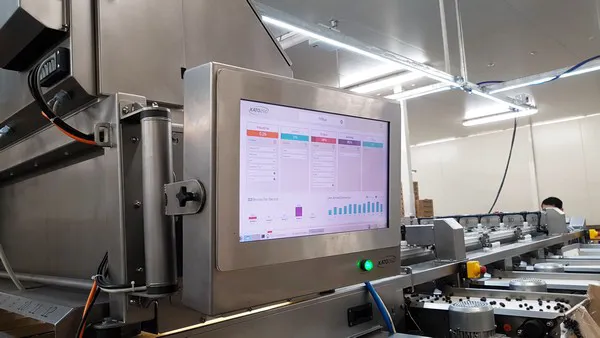Changes in the blueberry business are bringing new challenges to packhouses. There are now pressures to improve both quantity and quality – and solutions that make this possible. Joshua Miers-Jones, Global Category Director for Blueberries at TOMRA Food, explains:

“For blueberry businesses, this is a time of change. Global demand is climbing. Production is increasing. New growing regions are gaining market strength. And consumers’ quality expectations are rising. All these changes mean that growers and packhouses must now be more productive and efficient than ever before.
Demand for fresh blueberries more than doubled in the last decade and is expected to keep on climbing in the foreseeable future at a compound annual growth rate of about 7%. One reason for this exceptional growth is the heightened popularity of healthy foods in many nations around the world. Another reason is the transformation of blueberries from a seasonal product to one that’s sold all year round.
The number of countries producing more than 10,000 tons of blueberries annually has increased since 2010 from four to eleven. The U.S. still produces the greatest volume, followed by Canada; however, China will soon be the number one domestic producer of blueberries.
Demand for quantity and quality
This is more than just a commodity: retailers are selling an eating experience, and it falls on growers and packhouses to provide satisfactory products.
In the quest for higher quality fruit, significant investments are being made in cultivar research. Food science is leading to blueberries that are larger, firmer, sweeter and tastier.
Quantity and quality are targets that once pulled in opposite directions. Higher throughputs at packhouses tended to imply lower product quality. Greater quality tended to require slower sorting and grading speeds and lower throughputs. But this, too, has changed. And the game-changer is technology. Today’s state-of-the-art sorting, grading, and packing solutions can boost packhouse efficiencies by making the previously impossible possible.
The manufacturer of optical inspecting, sorting and grading machines for the food industry is TOMRA Food. TOMRA is also the only integrated line provider for blueberries, offering solutions for all varieties of blueberries, fresh to frozen, and handling everything from tipping the fruit onto the line to sorting, grading, and packing. The company also offers artificial intelligence for increased grading superiority across calyx, stem hole, and advanced defect detection.
TOMRA Food’s blueberry solutions are scalable, making them suitable for businesses of all sizes, from small family-owned farms to multinational corporations
Innovation through R&D
One reason for the effectiveness of TOMRA’s packhouse solutions is the company’s longstanding culture of innovation through a commitment to research and development. This includes an in-house Fruit Science Program, run from the company’s Field Research Centre in Waikato, New Zealand. This boasts a production design facility, cool storage, a facility for full test simulations, engineering space, and fruit science test labs.
Another reason is TOMRA’s acquisition of BBC Technologies, which originated when blueberry growers in New Zealand invented a grader and sorter that they commercialized and sold to other growers.
The previously impossible is now possible
The precision sorting and grading system for blueberries is the KATO 260. Compact, to minimize floor-space requirements, and designed to handle the fruit gently to maximize bloom retention and shelf life, this versatile system is suitable for any fruit sorting condition.
Then the KATO 260’s unique rolling conveyor system singulates and rotates blueberries to allow for a complete 360-degree surface inspection. Cameras take multiple pictures of each piece of fruit, and for precision grading, the machine’s software can identify defects as small as 0.2mm. What’s more, this system’s unrivaled guardianship of product quality is complemented by an ability to deal with great quantities: it can sort at speeds of up to 286 or 572 berries per second.
A valuable optional add-on for the KATO260 is a software and hardware package called LUCAi, which employs artificial intelligence to classify and grade fruit with unprecedented accuracy.
Another game-changing innovation from TOMRA, launched in 2022, is the KETE16 robotic case packing technology. This versatile, high-capacity, end-of-line system automates the process of placing punnets and clamshells into cases, trays, boxes, and crates.
The KETE 16 integrates seamlessly to match the speed and capacity of the CURO-16 packing system, the fastest fill-by-weight option on the market. As its name implies, the CURO-16 has 16 filling stations. These make it capable of handling up to 200 128-gram packs of fruit per minute.
Blueberry packers also use the CURO-8 packing system, with eight filling stations and a smaller footprint. This can handle 110 packs per minute. These machines increase productivity by reducing human handling errors and fruit give-away, and can simultaneously pack for different markets.
By adopting these various solutions, blueberry packhouses can handle large quantities while also ensuring high quality - and can take action to optimize operational efficiencies and enhance profitability. This is why there are more than 2,400 lanes of KATO260 optical sorters installed globally, why more are installed every month – and why, despite increasing competitive pressures, packhouse owners who invest in the best equipment can look to the future with confidence.”
For more information:
Joshua Miers-Jones
TOMRA Food
https://www.tomra.com/en/solutions/food/fruit/blueberries
